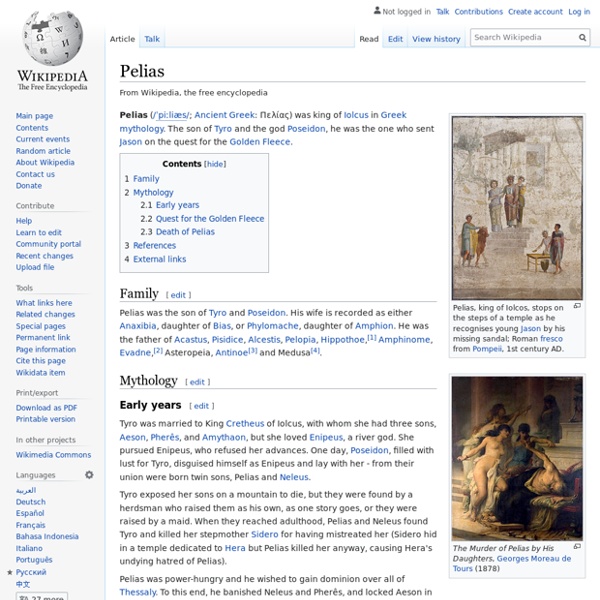Proserpina
Ancient Roman goddess Cult and myths[edit] Origin as Libera[edit]
Apollonius of Rhodes
ancient Greek epic poet Apollonius of Rhodes (Ancient Greek: Ἀπολλώνιος Ῥόδιος Apollṓnios Rhódios; Latin: Apollonius Rhodius; fl. first half of 3rd century BCE), was an ancient Greek author, best known for the Argonautica, an epic poem about Jason and the Argonauts and their quest for the Golden Fleece. The poem is one of the few extant examples of the epic genre and it was both innovative and influential, providing Ptolemaic Egypt with a "cultural mnemonic" or national "archive of images",[1] and offering the Latin poets Virgil and Gaius Valerius Flaccus a model for their own epics. His other poems, which survive only in small fragments, concerned the beginnings or foundations of cities, such as Alexandria and Cnidus places of interest to the Ptolemies, whom he served as a scholar and librarian at the Library of Alexandria. Life[edit]
Pygmalion
Pygmalion or Pigmalion may refer to: Mythology[edit] Stage[edit] Film[edit] Music[edit] People[edit]
Pagasae
Map showing ancient Thessaly. Pagasae is shown to the centre left at the head of its gulf. Pagasae or Pagasai (Ancient Greek: Παγασαί, romanized: Pagasaí)[1], also Pagasa,[2] was a town and polis (city-state)[3] of Magnesia in ancient Thessaly, situated at the northern extremity of the bay named after it (Παγασητικὸς κόλπος, or Latin: Pagasaeus Sinus).[4][5][2][6] As of the nineteenth century, the ruins of the ancient city were to be seen near Volos, which has given the modern name to the bay.
Pyramus and Thisbe
Plot[edit] In Ovid's Metamorphoses, Pyramus and Thisbe are two lovers in the city of Babylon who occupy connected houses/walls, forbidden by their parents to be wed, because of their parents' rivalry. Through a crack in one of the walls, they whisper their love for each other. They arrange to meet near Ninus' tomb under a mulberry tree and state their feelings for each other.
Iolcus
Place in Greece Mythology[edit] Pelias sends forth Jason, in an 1879 illustration from Stories from the Greek Tragedians by Alfred Church. Coin (Chalkous) of Iolcus. 4th century BC. Obverse: Head of Artemis Iolkia.
Pyrrha
Deucalion and Pyrrha throwing rocks that become babies. Etymology[edit] In Latin the word pyrrhus means red from the Greek adjective πυρρός, purrhos, i.e. "flame coloured", "the colour of fire", "fiery red" or simply "red" or "reddish".[2][3] Pyrrha was evidently named after her red hair as Horace[4] and Ovid describes her as red haired. Mythology[edit]
Phrixus
Ancient Greek mythological figure Mythology[edit] Depiction of Phrixos flying on ram to Colchis on AE dichalkon struck in Halos, Phthiotis in 3rd century BC. Notes[edit] ^ Flying is conventional in modern treatments, but see D. S.
Ionians
The location of ancient Ionia on the coast of modern-day Turkey. When referring to populations, “Ionian” defines several groups in Classical Greece. In its narrowest sense, the term referred to the region of Ionia in Asia Minor.
Mathematician
A mathematician is someone who uses an extensive knowledge of mathematics in his or her work, typically to solve mathematical problems. Mathematics is concerned with numbers, data, quantity, structure, space, models, and change. History One of the earliest known mathematicians was Thales of Miletus (c. 624–c.546 BC); he has been hailed as the first true mathematician and the first known individual to whom a mathematical discovery has been attributed.[1] He is credited with the first use of deductive reasoning applied to geometry, by deriving four corollaries to Thales' Theorem. The number of known mathematicians grew when Pythagoras of Samos (c. 582–c. 507 BC) established the Pythagorean School, whose doctrine it was that mathematics ruled the universe and whose motto was "All is number".[2] It was the Pythagoreans who coined the term "mathematics", and with whom the study of mathematics for its own sake begins. As time passed, many mathematicians gravitated towards universities.
Argus
From Wikipedia, the free encyclopedia Jump to navigationJump to search Greek mythology[edit]
Samos
Regional unit in North Aegean, Greece Samos (,[1] also ;[2][3][4] Greek: Σάμος [ˈsamos]) is a Greek island in the eastern Aegean Sea, south of Chios, north of Patmos and the Dodecanese, and off the coast of Asia Minor, from which it is separated by the 1.6-kilometre (1.0 mi)-wide Mycale Strait. It is also a separate regional unit of the North Aegean region, and the only municipality of the regional unit. In ancient times Samos was an especially rich and powerful city-state, particularly known for its vineyards and wine production.



